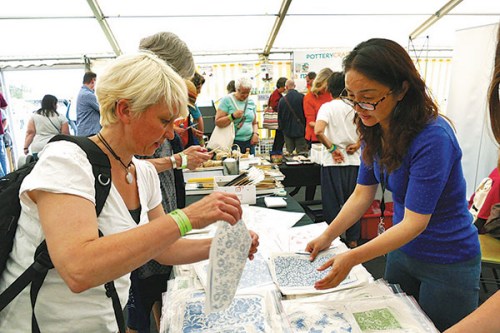
A ceramics artist from Jingdezhen shows off designs at an exhibition during the International Ceramics Festival in July at Aberystwyth on the coast of west Wales.(Photo provided to China Daily)
A thick layer of clay dust coats Jessie Lee's work tables and shelves. Her studio abounds with vases and pots, but pride of place goes to a ceramic candlestick decorated with lotus flowers and a Chinese dragon coiled around the neck.
"I've kept it for 40 years. It was my first piece of work," said the 67-year-old Malaysian-born British ceramics artist, speaking at her studio in High Wycombe on the outskirts of London.
"My teacher told me to make something, so I made the dragon candlestick. The Chinese influence was strong when I started to learn about pottery in the 1970s," she said, contemplating the dragon with its piercing claws, surrounded by trailing clouds.
Made from a material that was virtually unknown in Europe until the 1500s, Chinese porcelain caused a sensation in 16th-century Europe, and collecting fine works became popular among the wealthy. By the 18th century the fever had spread to others.
Chinese porcelain, especially the famous blue and white ware, changed people's ideas of beauty, and the enormous demand encouraged European potters to try to replicate art works from the East. The influence of Chinese ceramics continues to inspire artists to this day.
"Chinese porcelain is extremely famous in the West, especially the wares made in Jingdezhen. Almost the entire collection of Chinese porcelain in the British Museum was made in Jingdezhen," Lee said, referring to China's ceramics capital in Jiangxi province. "For British potters, Jingdezhen is the place."
When she visited the ancient city in 2011, Lee was impressed to discover that the ancient pottery-making skills hadn't died out. She saw a man coil a pot simply by walking around the vessel.
"The pot was nearly a meter tall and too big for the wheel, so the man held a lump of clay and moved around at a certain pace so that it looked like he was dancing around the pot," she said. "It was an old way of making pots and was very beautiful. I was inspired and made a smaller coiled pot when I came back."
Last year, Lee returned to Jingdezhen for more inspiration. This time, she cut clay with a stretched coil spring to produce shapes such as waves and ripples.
"The local landscape inspired me. I could hear and see the streams the whole day and the whole night," she said. "Traditional Chinese artists also observe nature and then return to their studios to work."
The Sanbao Ceramic Art Institute, a private art center in a suburb of Jingdezhen, receives more than 200 foreign artists every year, including about 100 who arrive to work as artists in residence. Many of them come from the United Kingdom, said Li Wenying, the institute's manager.


















































